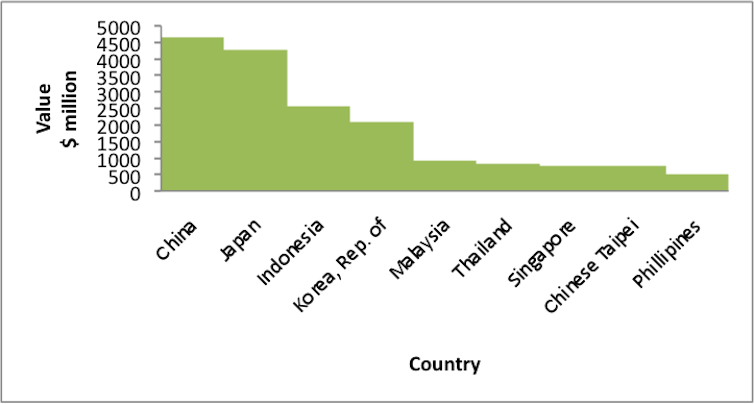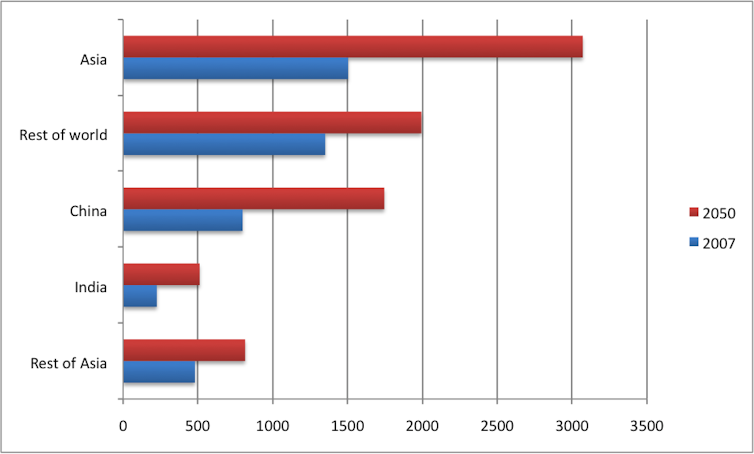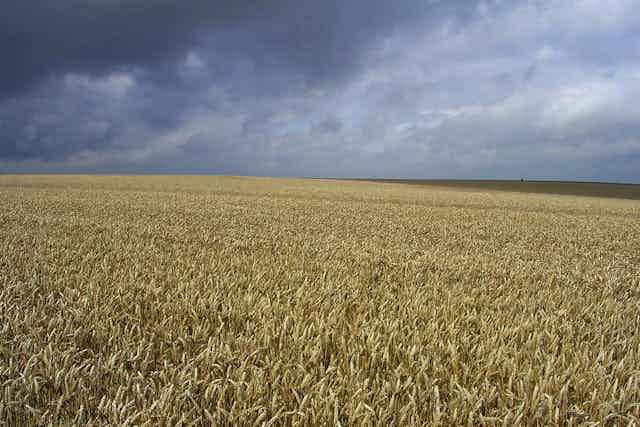Food production in Australia is challenging. Why? Because our soils are largely ancient and infertile, and our climate is variable and frequently harsh. Many food producing regions are degraded through soil erosion, acidification and salinity.
But effective application of research, an innovative culture, and low government subsidies have made agriculture a major industry.
Australia currently produces enough food - mostly beef, wheat and dairy - to contribute to the diets of about 60 million people. Australia is a net exporter of food, and exports around 70% of its production.


Through food production and the overseas application of Australian agricultural research and expertise, we contribute to the diets of up to 400 million people, mainly in Asia. In addition, we earn over $30 billion annually from food exports.
Food security is an increasingly critical issue, with food prices that are both high and volatile. In October 2012, the Food and Agriculture Organisation’s cereal price index was over 2.5 times the value of its 2002-2004 baseline. By 2050, the value of the global food market is projected to increase by over 70%.
In this context, Australia should consider how best to make use of our agricultural expertise to strengthen our farming sector while contributing to regional and global food security.
Global market for food
The annual value of global food imports was almost $300 billion in 2007, and this is estimated to grow to over $750 billion by 2050. The greatest growth is expected in Asia, particularly in China.
Overall food consumption will also grow. Projections suggest that demand in China will account for 43% of the global increase in consumption, with India responsible for 13% and the rest of Asia for an additional 15%. The largest growth is likely to be for fruit and vegetables, followed by meat and cereals.
In our main food market China, meat imports will be particularly important. It is expected that as the Chinese population becomes more affluent, the demand for beef and other meats will grow rapidly. There is a significant opportunity for Australia to contribute to meeting the projected increase in global demand for food.

The trade environment for food is an important element in strengthening food security. Only a small proportion of global food production is traded. In 2009, 2.5 billion tonnes of cereals were produced worldwide, but only 330 million tonnes or 13% was traded. The traded proportion for rice was less than 4%.
Food production in Australia
More than half of Australia’s land area is committed to agricultural activities such as livestock grazing, cropping and horticulture. The largest proportion (46%) of agricultural land is used for grazing of natural vegetation. However, most profits are derived from more intensive cropping and horticultural activities, especially through the use of irrigation.
Australia is a major food exporter and is globally seen as a reliable supplier of high quality food. We are the world’s second largest beef exporter and fourth largest wheat exporter. But as most food is not traded, we account for only a small part of total global production: 2.9% of beef and 3.4% of wheat.
Future increases in food production will be dependent on gains in productivity, which gives an indication of our capacity to harness human and physical resources to generate output growth. For example, we will need to better use limited, and in some cases diminishing, resources such as arable land and water.

The Australian agriculture sector has historically experienced relatively strong productivity growth, typically above the average productivity growth in the broader economy. Within the agriculture sector, productivity growth has been particularly high among large or broadacre cropping farms. However, after four decades of over 2% per year average growth in total factor productivity in broadacre agriculture, the last decade has seen a reversal of this trend.
Increasing our food production
We have some scope to increase food production by bringing more land into production and by increasing the intensity of farming. However, the amount of land suitable for agricultural production is limited and we are also strongly constrained by access to water and our sensitivity to climate and its variability.
Food production in Australia could be increased mainly through increases in cropping intensity and more efficient use of the available resources. It has been estimated that by 2050, the real value of Australian agrifood production could be almost 80% higher than in 2007, representing an average annual increase of 1.3%. The largest increases are expected in beef, wheat and dairy products.
Increases in food production will need to be managed carefully to avoid environmental and social disruption. For example, in Australia we currently produce wheat on around 13 million hectares of land with an average yield of only 1.5 tonnes per hectare. Analysis of our production potential has suggested that about 47 million hectares could be used for wheat production and average yields could grow to 4.4 tonnes per hectare. This suggests Australia could lift wheat production from just under 20 million tonnes to over 200 million tonnes.
However, such an increase would come at a great cost. It would involve massive land clearing, and directing all available land and all water available for irrigation towards wheat production and would reduce our production and export of other types of food. This is unlikely to be an effective way of contributing to food security.
A number of challenges will need to be addressed if we are to sustainably increase food production. These are among the factors being considered as part of the Australian Government’s first ever National Food Plan.
Agricultural research and development
Australian research in agriculture has been highly successful and is well regarded internationally. The standard and quality of research in Agricultural and Veterinary Sciences and their sub-disciplines rated highly in the Excellence in Research for Australia assessment. This research is increasingly linked with research in Asia, South America and Africa.
However, agricultural research spending has been stagnating. Agricultural R&D intensity has fallen from a peak of five per cent of the value of agricultural production in the 1970s, to just above three per cent in 2007.
The decline in Australian broadacre agricultural productivity has been linked to this slowdown in research activity, together with the impacts of a changing climate. Support for research is important over long timescales: there is a lag effect from R&D investment to productivity gain, with the effects often continuing beyond 35 years after initial investment. Revitalising investments in agricultural R&D will be crucial to lifting our food output.
Workforce
Australian agriculture has an ageing workforce. From 1976 to 2001, the number of farmers aged in their 20s declined by over 60%. Many individuals are moving from rural Australia to larger regional centres or cities in search of greater work options, better health and education services. This in turn has dramatic effects on the regional skills profile, its labour pool, and the general health and vitality of rural and regional communities.
Also, there is considerable attrition among university students studying subjects in agriculture. This has implications for the future supply of researchers, scientists and professionals in the field of agriculture.
Infrastructure
Infrastructure plays a major role in moving commodities in an efficient and cost-effective manner, and access to adequate infrastructure will be critical in ensuring Australian agriculture remains competitive. Competition for road, rail and port infrastructure leads to difficulties and delays in transport and increases costs, particularly where goods are perishable or live animals are involved.
Optimising usage of our water resources will require substantial improvements in current irrigation schemes. These issues will be particularly important if we explore the opportunities for intensive agricultural production in northern Australia.
Conclusions
Australia is a stable producer of food in the world market, and food exports are important to our economy. However, the world population is already over 7 billion and is projected to grow to over 9 billion by 2050. We produce enough food to contribute to the diets of less than 1% of those people, and less than 2% of people living in Asia.
Neither Australia nor any other country can directly act as the “food bowl” of the world or a large, populous region. Our most valuable assets to support food security in our region and the world are our knowledge of agricultural science, and the ingenuity our farmers have used to produce food on a continent fraught with environmental challenges. We are well placed to apply the outcomes of agricultural R&D in Australia and developing countries, across a range of commodities.
Australia may not be directly able to feed Asia or the world. But our know-how in food production has the potential to contribute to the diets of hundreds of millions of people around the globe.
Acknowledgements
We thank Dr Kim Ritman, Dr Brian Keating, and Professor Philip Pardey for comments on an earlier draft of this paper.
This is an edited version of an article that appeared in the Office of the Chief Scientist’s Occasional Paper Series.


